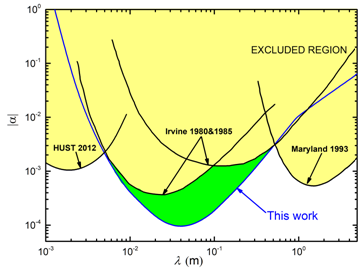For a long time, scientists have been trying to unify the four basic interactions (electromagnetic, weak, strong and gravitational) in nature; to this end, theoretical physicists have put forward various theoretical models, such as large extra dimension theory, string theory, etc., but these theories require that some fundamental physical constants are not real “constants” (such as gravitational constant and fine structure constant which change over time), and Newton's law of universal gravitation, which states that the force of gravity between two objects is inversely proportional to the square of the distance, breaks at close range. The theoretical models should be tested by experiments, and high-precision experimental test of gravity will help people to have a deeper understanding of the nature of gravity.
On May 26, 2021, Physical Review Letters, an authoritative academic journal of physics, published online the latest research results of Prof. Luo Jie’s team of the School of Mechanical Engineering and Electronic Information of China University of Geosciences in the experimental tests of gravitational inverse-square law: “Combined test of the gravitational inverse-square law at the centimeter range” [10.1103/PhysRevLett.126.211101]. Ke Jun, a doctoral student of Grade 2020 of the School of Mechanical Engineering and Electronic Information, is the first author, and Professor Luo Jie is the corresponding author. This research is the result of cooperation between Professor Luo Jie’s team from the School of Mechanical Engineering and Electronic Information of China University of Geosciences and Professor Shao Chenggang’s team from the Gravity Center of Huazhong University of Science and Technology and Professor Yang Shanqing’s team from TianQin Research Center for Gravitational Physics Sun Yat-sen University, which is mainly based the experiments for measuring the gravitational constants published by the Gravity Center of Huazhong University of Science and Technology in Nature in 2018, and analyzes the non Newtonian gravitational effect in the experiment the by using the inconsistency between the two experiments. The research results provide the strongest limit of Yukawa form breaking between 50-500mm, and increase the current international best level by 7 times at 60-100mm, which has reached the international leading level provided an experimental reference for the theoretical research of this problem.
Ke Jun, the author of this paper, studied in the School of Mechanical Engineering and Electronic Information of China University of Geosciences (Wuhan) for his bachelor’s degree, joined Professor Luo Jie’s team to study for a master's degree in 2018, and became a doctoral candidate in 2020. The research has been supported by National Key R&D Program, National Natural Science Foundation of China, Major Fundamental and Application Research Projects of Guangdong Province and China University of Geosciences (Wuhan).
Paper link: https://link.aps.org/doi/10.1103/PhysRevLett.126.21110
